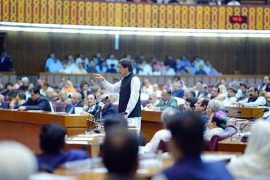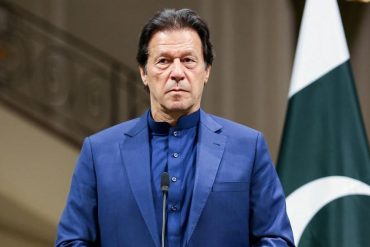STRAIGHT TALK by Hafeez Khan
It was approaching dusk when we reached the Mujahid camp in Attock. Our hosts had arranged a tour of the facility. It was a Spartan tent city serving as a base for training and recovery for groups returning after four to six weeks in combat zone.
We talked to a group leader who had just returned from Kandahar after their resistance activities. They hid during the day avoiding aerial attacks and trekked at night across Hindu Kush Mountains. He had some fascinating stories to share.
Another group was preparing to leave. Their kits were an eye opener. A bag of chick peas, a container of water, a few layers of clothing, chappals bound with cloth and their AK 47 with ammunition belts. The war was at its peak yet their spirits were high and unyielding. I realized their invincibility lay in their simplicity; Mujahids had nothing to lose. How could the Russian put down an uprising where survivors are “Ghazis” and dead achieve “Shahadat”?
Money and weapons initially came through Arab States acting as proxies, and then directly from USA. Starting as a trickle it went up to billions. Pakistan was the conduit who administered the program and distribution. Initial few years were brutal, USSR decimated Afghans at will with their helicopter gunships. Introduction of Stinger missiles was the game changer in this war. It blunted the Russians. Mujahidin bled USSR materially and in casualties leading to their withdrawal in 1988.
It led to the breakup of USSR. USA having achieved its target withdrew from the scene; dropping Afghanistan like a hot potato. Their focus shifted to Iraqi invasion of Kuwait. It created a power vacuum. The next seven years were mayhem under Communist Najibullah and warring factions.
The Arabs who fought Soviets and stayed on were a strong force. Initially called “Afghan Arabs” they morphed into Al Qaeda under Bin Ladin. They had a well financed presence promoting a combative fundamentalist Islam.
Mujahidin were never a unified force. After the war they degenerated into regional Warlords promoting self interest fed by outside powers. Saudi Arabia, Pakistan, Iran and India had conflicting agendas and they supported their own factions.
The traditional Afghan tribal structure was completely broken. Local Commanders carved out their territories ruthlessly putting down opponents. Ordinary Afghans had no protection against kidnappings, murder, rape, looting and extortion. They ached for security and an end to the conflict. That is when Taliban emerged.
Taliban movement started from the South. It gained traction as a force promoting peace, de-weaponization and enforcement of Sharia. The Afghans desperate for peace responded including refugees, former mujahidin, and madaris students in Pakistan.
Mullah Umar, a Pushtun, emerged as a Robin Hood for the oppressed. Taliban territorial conquest began October 1994 and continued till August 1998 establishing their writ. Material support was forthcoming from Pakistan along with thousands of volunteers. Pakistan was always more comfortable in supporting Islamists versus Nationalist factions.
In 1996 Osama Bin Ladin relocated to Taliban’s Afghanistan. There was a confluence between Taliban and Bin Ladin’s needs. Al Qaeda fought alongside untrained Taliban. Mullah Umar chose international ire as host while Bin Ladin used Afghanistan as a sanctuary to further his Agenda. The 1998 US embassy bombings and attack on World Trade Center unfolded from Afghanistan.
The reaction was global condemnation. Osama Bin Ladin had boxed way above his weight. President Bush vowed to crush the terrorists and zeroed in on Al-Qaeda. Within a month USA and its allies moved in, supported by Northern Alliance.
Taliban fought back in defense of Osama but their defense crumbled quickly. UN authorized a transitional administration. Hamid Karzai headed the new government. Bin Ladin and Mullah Umar escaped from their hideouts and their followers withdrew to the mountains. USA and allies launched a massive operation in Gardez in March 2002.
In August 2002, I flew into Kabul with my friend, more of a younger brother, Niaz Ali Shah. Our host was Hashmat Ghani, younger brother of President Ashraf Ghani. Nothing could prepare me for what I witnessed. The Kabul I had visited seemed to have gone though a severe bout of small pox. It was pock marked, destruction all around, a skeleton of what I had seen.
People were scared, suspicious, wrecked by a merciless war. Security was a serious issue with bunkers, road blocks, and bomb proof walls. It was one of the most depressing five days of my life despite the extreme generosity of our host.
Afghanistan was unfinished business yet Pentagon was distracted by Saddam Hussein’s Iraq. Events between 2001 and 2019 have been documented in multiple books and difficult to summarize in an article. I will highlight some phases it went through. The shock and awe of NATO forces sent the opponents scurrying away. Initially they prevailed.
However lack of knowledge of terrain and local culture lost them the advantage. Their efforts of reconstruction were ad hoc and disorganized compounded by corruption amongst Afghan leadership. Heavy bombardment causing civilian casualties gave Taliban the opportunity to re-emerge. They struck back through suicide attacks and remotely detonated bombings.
All the effrts to usher in democracy gave mixed results. War weariness crept in and cracks appeared in the Coalition Forces. In 2009 President Obama focused on countering Taliban insurgency by dismantling Al Qaeda safe havens and hunted down Bin Laden in 2011. But the results were elusive. Under public pressure he announced troop’s withdrawal in 2014.
By 2017 the war was stalemated. In 2018 Taliban, now battle hardened mounted a series of bold attacks. President Trump started off with accusing Pakistan of “deceit and lies” but changed direction when Prime Minister Imran Khan came to office. US sought help from Pakistan to negotiate with Taliban.
Peace talks in 2019 resulted in a deal between US and Taliban in February 2020. US agreed to release 5,000 prisoners. It was followed by recent peace talks between Afghan Government and Taliban. After more than trillion dollars in US costs there seems to be hope to end Afghan blood shedding. Pakistan is credited around the world for playing a pivotal role.





